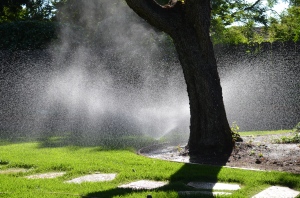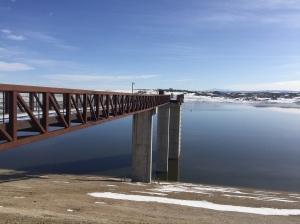
Highlands Ranch, home to 93,000 people in south metro Denver, relies on a combination of South Platte River water and groundwater. Photo used with permission from flickr, some rights reserved.
By Eric Hecox
In 2007, the Colorado Foundation for Water Education published its Citizen’s Guide to Denver Basin Groundwater, devoting particular attention to the south Denver metro region. The region had experienced rapid growth and was historically over-reliant on groundwater aquifers.
Water leaders throughout the South Metro area, which includes parts of Douglas and Arapahoe counties, recognized the need to secure a more sustainable water supply.
The South Metro Water Supply Authority had formed several years earlier, in 2004, bringing together water providers from throughout the region, and had begun to execute a plan to do just that. The pillars of the plan are efficiency, partnership and investment.
Fast-forward to 2015, and the water landscape of the South Metro region is vastly improved:
- In little over a decade, we reduced per capita water demand across the region by 30 percent and are doing even more through regional conservation approaches.
- Aquifer declines, although still occurring, have slowed significantly, from 30 feet per year to 5 feet per year, as we transition to a more sustainable water supply.
- Under our current plan, we project the region’s water supply will be 55 percent renewable by 2020, a significant increase from just 10 years ago.
Despite this significant progress, there is more work to be done to put the region on a sustainable path.
Our Plan in Action: Efficiency and Reuse
Since 2004, South Metro Water Supply Authority and its 14 water provider members have followed the “all of the above” approach to maximizing existing supplies. The approach mirrors strategies in Colorado’s draft state water plan and continues to underpin our region’s approach to creating a secure water future.

Outdoor watering accounts for 50 percent of single-family residential water use in Colorado on average. Photo by Eric Sonstroem, some rights reserved.
The approach begins with conservation. A few examples of efforts that have led to our 30 percent reduction in per capita water use since 2000 include:
- Providers serving Highlands Ranch and Castle Rock are two of only three in the state to put water customers on a water budget that tracks water use by household.
- Sterling Ranch is conducting the state’s first rainwater harvesting pilot study.
- Inverness provides rebates for replacing turf with low water-use landscaping.
Recognizing conservation alone is not enough to meet long-term needs, our plan calls for maximizing efficiency of existing resources.

Reuter-Hess Reservoir in Parker will store reuse and other renewable water in Douglas County. Photo by Mikal Martinez.
Most of our members are approaching full use of their reusable supplies thanks to infrastructure investments and collaboration. Two of our members, serving Inverness and Meridian, are among the state’s earliest adopters of water reuse and today reuse 100 percent of collected wastewater. Last year, Meridian was honored as the “Water Institution of the Year” by the national WaterReuse Association.
New state-of-the-art treatment plants have also come online in recent years that significantly increase our region’s ability to reuse water.
We also are investing in studying and implementing Aquifer Storage and Recovery (ASR), which has great potential to convert our existing groundwater resources to a valuable drought supply, much like a savings account.
Collaboration and Investment

The WISE Project is a collaborative project between Aurora Water, Denver Water and 10 members of the South Metro Water Supply Authority to share water supply and infrastructure.
Regional cooperation is another key tenet of the draft Colorado’s Water Plan that is playing out in the south Denver suburbs. Through local and regional partnerships, we are getting more use out of existing infrastructure and supplies.
The WISE Project is a first-of-its-kind partnership with Denver Water and Aurora Water that bolsters water supplies to the south Denver suburbs while maximizing existing water assets in Denver and Aurora. Similarly, Arapahoe County Water and Wastewater Authority and East Cherry Creek Valley partnered to complete a state-of-the-art water treatment plant in 2012 and are working with several other South Metro Water Supply Authority members to share capacity on the East Cherry Creek Valley Northern Pipeline.
These are only a few of the innovative efforts underway in the south Denver metro area.
Learn more about our plan by visiting our newly revamped website, southmetrowater.org, where you can sign up for updates and engage with us on social media. Let us know what you think.
 Eric Hecox is the director of the South Metro Water Supply Authority, a regional water authority comprised of 14 water provider members that collectively serve more than 300,000 residents as well as businesses in the south metro Denver area. South Metro Water’s membership spans much of Douglas County and parts of Arapahoe County, including Castle Rock, Highlands Ranch, Parker and Castle Pines. Eric also serves on the board for the Colorado Foundation for Water Education.
Eric Hecox is the director of the South Metro Water Supply Authority, a regional water authority comprised of 14 water provider members that collectively serve more than 300,000 residents as well as businesses in the south metro Denver area. South Metro Water’s membership spans much of Douglas County and parts of Arapahoe County, including Castle Rock, Highlands Ranch, Parker and Castle Pines. Eric also serves on the board for the Colorado Foundation for Water Education.

 Print
Print
Reblogged this on Coyote Gulch.
Why are we allowing the Oil & Gas companies to dispose our water after using it for hydraulic fracturing by dumping it down old vertical wells and hoping we never see it again in geologic time? In stead of encouraging, persuading or demanding that they recycle all of this water back to the condition that they purchased it. Then down steam users can benefit and we as a state would be protecting our most precious resource WATER.